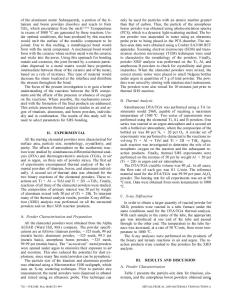High Pressure-High Temperature Reactions in Xenon-Chlorine System
- PDF / 503,169 Bytes
- 6 Pages / 612 x 792 pts (letter) Page_size
- 57 Downloads / 382 Views
0987-PP04-07
High Pressure-High Temperature Reactions in Xenon-Chlorine System Maddury Somayazulu, Steven Gramsch, Ho-Kwang Mao, and Russell Hemley Geophysical Laboratory, Carnegie Institution of Washington, 5251 Broad Branch Rd. NW, Washington, VA, 20015 ABSTRACT We present results of studies of the xenon-chlorine system to 60 GPa and temperature range 300 to 2000 K. Using a combination of Raman spectroscopy, infrared spectroscopy and synchrotron x-ray diffraction; we characterize the products of diamond cell experiments. In the 2-20 GPa pressure interval, we observe the formation of a deep red crystalline phase. Above 15 GPa, and at high temperature, a solid solution of Xe and Cl2 appears to form. Comparison of the ultraviolet-visible and infrared absorption measurements on the proposed alloy of Xe and Cl2 show that band edge moves into the visible range at high pressure. INTRODUCTION Since the synthesis of XeF2 and XeF4 [1], there have been many efforts to synthesize other rare gas halides. Xenon dichloride was first observed in condensed products of a xenon-chlorine mixture from a microwave discharge [2], but considerable ambiguity exists whether the compound XeCl2 is a van der Waals complex or a stable, linear molecule [3]. XeI is reported in the low-pressure electrical discharges of Xe and I2 mixtures [4]. Indeed, the search for new molecular species such as XeICl, XeCl4 and XeI4 is motivated by the possibility of developing new excimer laser sources [5]. van der Waals compounds, disordered alloys and solid solutions can form when mixtures of molecular systems are compressed at modest temperatures [6]. At the same time, these mixtures can lead to the formation of novel compounds when the mixtures react at high temperatures [7]. Indeed, the molecular end-member systems themselves are observed to form complex polymeric phases and non-molecular systems at simultaneous high-temperature and high pressure conditions [8]. The literature on the mutual solubility and phase diagrams of binary molecular mixtures, however, is far more limited than that of metal alloys. Depending on the ratio of the effective radii of the molecular species, simple space filling rules predict the formation of AB, AB2 or AB13 when a binary mixture freezes [9]. This analysis assumes, however, that the volume term dominates the Gibbs free energy and that the interaction between molecules is purely van der Waals in nature. Based on these molecular packing considerations, if the ratio of molecular diameters is greater than 0.85, a mixed, binary solid is obtained. The fact that a number of compounds have been reported in He-N2 [10]; Xe-N2 [6]; Ar-H2 [11] that are not predicted by such space-filling rules, however, indicates that under pressure, the rare gas complexes distort sufficiently to affect the interactions between the two species and therefore allow the formation of compounds that are dictated by the mixing entropy term in the free energy.
EXPERIMENTAL DETAILS Our general strategy was to load Xe and Cl2 into a diamond anvil cell (DAC)
Data Loading...










